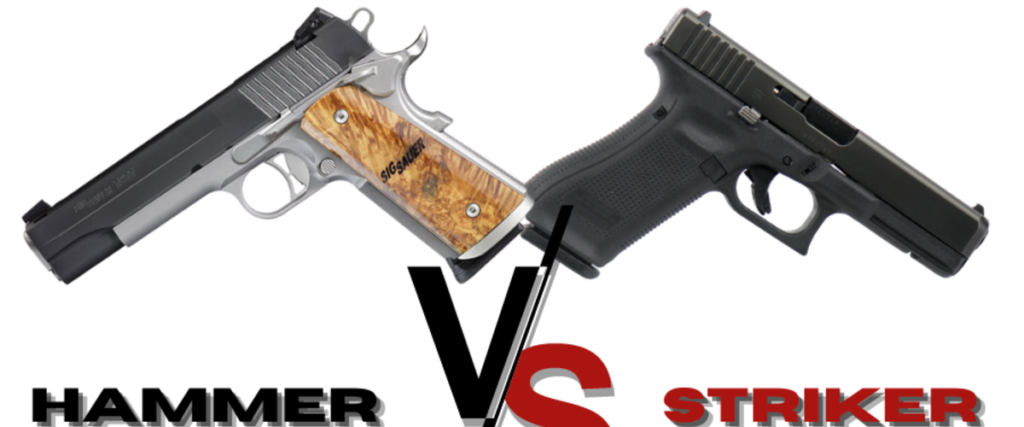
Following up on our last resource, Anatomy of a Handgun, this article discusses the difference between a handgun that is hammer-fired and one that is striker-fired.
The lifelong debate
Some incredibly iconic handguns are hammer-fired such as the old-west Colt six-shooters, the Browning 1911, and the Smith & Wesson police revolvers seen in nearly every 20th-century action movie. Hammer-fired handguns have withstood the test of time and are still manufactured to this day for those that wish to have a pistol that can be double or single action. Striker-fired handguns, however, are more modern and have seen a huge increase in commercial adoption in the last few decades due to some big brands like Glock, FN-America, Sig Sauer, and Smith & Wesson. Many individuals claim hammer-fired pistols to be tried and true, while others think striker-fired is the future with its ease of operation and safety features. Firearm enthusiasts often debate which platform is superior to the other. And although this debate may go on for future decades, it’s important to remember to do independent research and select the firearm that best suits your needs. Throughout this article, we will go over some of the major differences below so that you can make a more informed and confident decision when it comes time for you to select your newest handgun.
Pro Tip: One of the easiest ways to differentiate between these two types of handguns is to look at the back of the slide or body to see if there is a hammer present. However, some hammer-fired pistols will not have an exposed hammer.
HAMMER-FIRED
Hammer-fired handguns have been around for an incredibly long time and have not had to change much over the course of its history. This is mostly because the design needs very little innovation and has served their owners well for numerous generations. It’s important to note that hammer-fired pistols can come in either single action or double action configurations and it’s up to you to determine what will work best for your needs.
A single-action semi-automatic pistol needs to be manually cocked the first time and then will arm itself after each shot by using the recoiling slide to cock the hammer. In contrast, a double-action semi-automatic pistol will cock the hammer and fire the round with the first trigger pull and then be single-action for every subsequent shot since the recoil of the slide will cock the hammer for the following shot.
A single-action revolver will need to have the hammer manually cocked between every shot. Whereas double-action revolvers have triggers that cock the hammer and fire the gun with every pull. It should be noted that double-action triggers usually have a high trigger pull weight since the trigger has to both cock the hammer and drop it as well. This can be off-putting at first but with practice, one can become accustomed to it fairly quickly.
Some of the pros of having a hammer-fired handgun are external safeties that can be used to lock the hammer in place, decock the hammer safely, or lock the firing pin from being released. Due to the higher pull weight of a double-action, some prefer this type of pistol for carrying because it requires a more deliberate trigger pull in order to fire a round. In the same vein, some find single-action pistols to be easier to shoot because the weight of the trigger pull is incredibly low so there is less movement that can affect your accuracy and aim. Some find that they shoot straighter with single-action as opposed to other types of handguns.
H1: Smith & Wesson Model 19, H2: Sig Sauer 1911, H3: Smith & Wesson Bodyguard, H4: FN FNX-45 Tactical
STRIKER-FIRED
Striker-Fired handguns have been around for decades but only recently became popular with the introduction of Glock’s striker-fired handgun. Since that time many other manufacturers have put out their own models of striker-fired pistols as they are said to be easier to pick up and shoot.
With a striker-fired handgun, there is no hammer present. When the slide is racked back and released forward, the firing pin remains back and under spring tension. The trigger releases this tension and allows the pin to push forward resulting in firing the round in the chamber. Striker-fired pistols are fairly simple in their operation because after the shooter manually racks the slide to chamber a round, each trigger pull fires a single round, ejects the spent casing, loads another round into the chamber, rearms the firing pin, and is ready to be shot again. Because there is no hammer to cock or release, the trigger pull of most striker-fired pistols are incredibly easy to pull and have low pull-weights.
Due to this ease of use, many new shooters find themselves gravitating to striker-fired handguns because it helps to build confidence and good shooting habits without having to worry about single vs double action triggers. Many also find striker-fired pistols to be easier to hold and carry because most have polymer frames that are lighter weight.
S1: Glock 17 GEN5, S2: Walther PPQ, S3: FN 509, S4: Smith & Wesson M2.0
As always, the pros and cons of all firearms depend on the individual who is shooting, as each person will have a preference in pull weight, action type, caliber, grip angle, and numerous other factors. For this reason, it’s always highly recommended to rent and test many different types of handguns to find what fits best in your hand and allows you to shoot accurately and with good form.
Let Us Help
Stop by Triangle Shooting Academy today, and our team of firearm experts will be happy to assist you in choosing the correct firearm for your needs.
Follow Us
Keep up with the latest updates on our Facebook and Instagram accounts.
